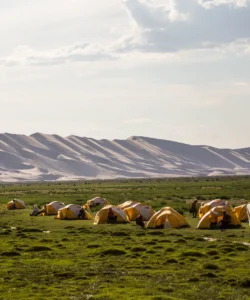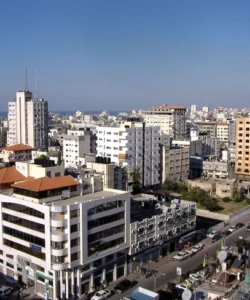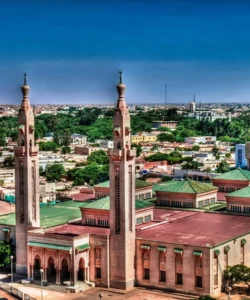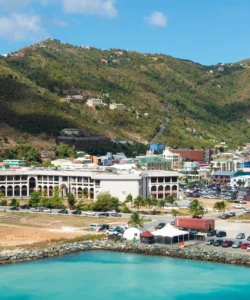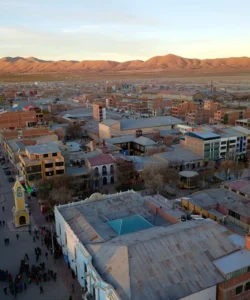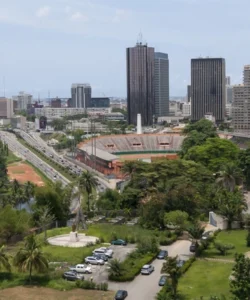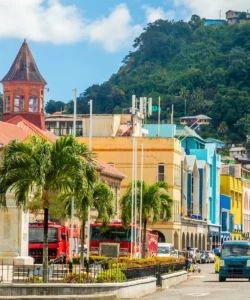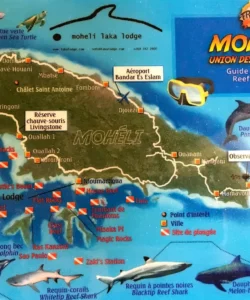Bermuda is a British Overseas Territory in the North Atlantic Ocean, known for its distinctive pink sand beaches, clear turquoise waters, charming pastel-colored houses, and a rich history blending British, American, and West Indian influences. It’s often mistaken for a Caribbean island, but it’s actually much further north, off the coast of North Carolina.
Listen to an introduction about Bermuda
![]()
Area and Population:
Bermuda consists of about 181 islands and islets, with a total land area of approximately 54 km² (21 sq mi). Its population is around 63,940 inhabitants (as of 2025). Despite its small size, it’s one of the most densely populated territories in the world.
Language:
The official language of Bermuda is English. Bermudian English has its own unique accent and some local slang, but it is easily understandable to other English speakers.
Currency:
The currency of Bermuda is the Bermudian Dollar (BMD), which is pegged at par with the U.S. dollar. U.S. dollars are widely accepted throughout the island, and credit cards are commonly used.
Religion:
The predominant religion in Bermuda is Christianity, with Anglicanism (Church of England) being the largest denomination. Various Protestant denominations, as well as Roman Catholicism and other faiths, are also present, reflecting the island’s diverse heritage.
Capital:
The capital city of Bermuda is Hamilton, located on the main island of Bermuda. It is the economic and political center, known for its vibrant harbor, charming colonial architecture, and duty-free shopping.
Major Cities/Towns:
Bermuda is not typically described in terms of “cities” beyond Hamilton, but rather parishes and historic towns.
- St. George’s (Town of St. George): A UNESCO World Heritage site, the oldest continuously inhabited English settlement in the New World, known for its beautifully preserved historic buildings and colonial charm.
- Flatts Village: A small, picturesque village known for its sheltered inlet and the Bermuda Aquarium, Museum & Zoo.
- Somerset Village: A relaxed village in the west end, known for its drawbridge and charming atmosphere.
Attractions and Wonders:
Bermuda’s attractions combine its natural beauty with its unique history and culture.
- Pink Sand Beaches: Bermuda is famous for its stunning pink sand beaches, a result of crushed coral and shell fragments mixed with sand.
- Horseshoe Bay Beach: One of the most iconic and photographed pink sand beaches.
- Warwick Long Bay: A long stretch of pink sand backed by dunes and coastal rock formations.
- Church Bay: Known for its excellent snorkeling within its protected cove.
- Crystal Caves & Fantasy Caves: Magnificent underground caves with stunning stalactites, stalagmites, and clear, deep pools.
- Town of St. George (UNESCO World Heritage site): Explore its narrow lanes, historic churches (e.g., St. Peter’s Church, the oldest Anglican church in the Western Hemisphere), the State House, and Tucker House Museum, immersing yourself in its 17th-century atmosphere.
- Hamilton: Stroll along Front Street with its pastel-colored buildings, enjoy duty-free shopping, visit the Bermuda Historical Society Museum, and explore Fort Hamilton for city views.
- Royal Naval Dockyard: A historic complex in the West End, now a vibrant hub with museums (e.g., National Museum of Bermuda), artisan shops, restaurants, and attractions like Dolphin Quest.
- Snorkeling and Diving: The clear, shallow waters surrounding Bermuda are excellent for snorkeling on reefs and exploring numerous shipwrecks.
- Bermuda Triangle: While more of a mystery, Bermuda is one of the “points” of the famous Bermuda Triangle, adding an intriguing element to its mystique.
- Gibbs Hill Lighthouse: One of the oldest cast-iron lighthouses in the world, offering panoramic views of the island after climbing its 185 steps.
- Railway Trail: A scenic walking and cycling path along the route of Bermuda’s former railway, offering beautiful coastal and inland views.
Architecture:
Bermuda’s architecture is a distinctive blend of British colonial styles adapted to the island environment, characterized by its iconic white stepped roofs and pastel-colored walls.
- White Stepped Roofs: These roofs, made of limestone slates, are designed to collect rainwater, a crucial feature on an island with no freshwater springs. Their stepped design helps filter the water.
- Pastel Hues: Houses are typically painted in a range of soft pastel colors, which is aesthetically pleasing and helps reflect the sun’s heat.
- Limestone and Wood Construction: Traditional homes are often built from local limestone (coral stone) or wood.
- Colonial Details: Features like verandas, louvered shutters, and sash windows are common, reflecting British influence.
- Town of St. George: Showcases classic 17th and 18th-century colonial architecture, beautifully preserved.
Roads:
Bermuda has a well-maintained road network covering its small land area. The maximum speed limit is 35 km/h (22 mph), making for a leisurely pace of travel. Private car ownership is restricted, and visitors cannot rent cars. The primary modes of transport for tourists are scooters/mopeds, which are widely available for rent, or public buses and taxis. Roads are narrow and winding in places. Driving is on the left side of the road.
Hotels:
Bermuda offers a range of high-end to mid-range accommodation, with a focus on luxury resorts and charming boutique hotels. Budget options are less common.
- Luxury Resorts: Examples include Hamilton Princess & Beach Club (Fairmont), The St. Regis Bermuda Resort, and Rosewood Bermuda, offering extensive amenities, golf courses, and private beach clubs.
- Boutique Hotels and Guesthouses: Smaller, often historic properties providing a more intimate and personalized experience.
- Cottage Colonies: A unique Bermudian accommodation style, offering private cottages with shared amenities.
- Vacation Rentals: Many private homes and apartments are available for rent, particularly for longer stays.
Restaurants and Cuisine:
Bermudian cuisine is a delicious blend of British, American, Portuguese, and West Indian influences, with a strong emphasis on fresh seafood.
- Fish Chowder: Considered the national dish, a rich, dark, flavorful soup, often seasoned with Outerbridge’s Original Sherry Peppers Sauce and black rum.
- Fish Sandwich: A popular local staple, typically deep-fried fish (often snapper or mahi-mahi) served on raisin bread with tartar sauce, coleslaw, and hot sauce.
- Codfish and Potatoes: A traditional Sunday breakfast, consisting of boiled salt cod, boiled potatoes, onions, and sometimes a hard-boiled egg and a butter sauce.
- Shark Hash: A unique local dish made from shark meat, often served with Johnnybread (a fried cornmeal bread).
- Hoppin’ John: Peas and rice, similar to Caribbean versions.
- Spiny Lobster: In season (September-March), fresh local lobster is a delicacy.
- Bermuda Triangle Cocktail: A signature drink, often rum-based.
- Rum Swizzle & Dark ‘n’ Stormy: Iconic rum cocktails.
- Bermuda Onions: Famous for their sweetness, often used in salads and relishes.
- Restaurants: Hamilton offers a diverse range of dining options, from upscale restaurants serving international cuisine to more casual local eateries. Resorts often have multiple dining venues. Seafood is a highlight across the island, and many establishments offer outdoor dining with ocean views.

